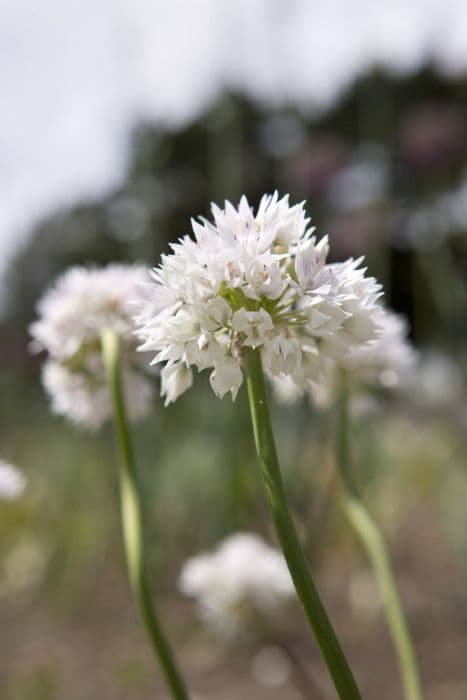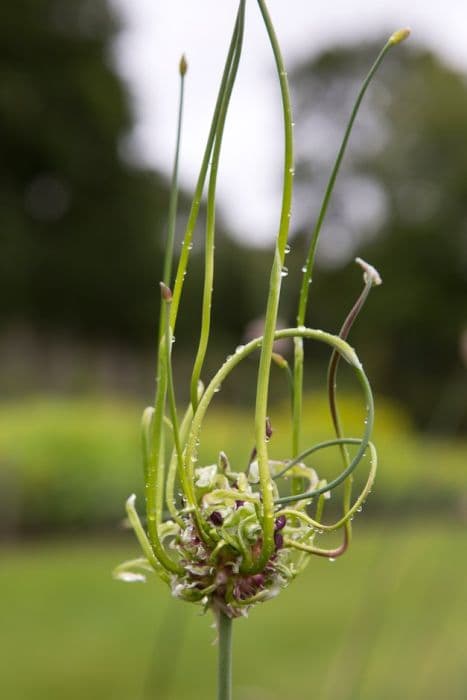Persian Onion Allium jesdianum 'Early Emperor'

ABOUT
The 'Early Emperor' is an ornamental plant known for its showy and attractive flowers. Its most striking feature is the large, spherical flower cluster, which consists of many small, star-shaped flowers that come together to form a dense globe. These globes are held atop sturdy, upright stems that rise above the foliage. The flowers exhibit a rich purplish-pink hue which can add a vibrant splash of color to a garden setting. The foliage of 'Early Emperor' is also noteworthy, with its sleek, strap-like leaves that have a deep green color. These basal leaves form a neat, clumping mound from which the flowering stems emerge. The plant blooms in the late spring to early summer, with the flowering period being one of the most anticipated displays in the garden. The leaves typically wither away after blooming, allowing the flowers to take center stage. The overall form of the 'Early Emperor' is both elegant and architectural. It's appreciated for its vertical presence in the landscape, with the flower heads creating a strong visual impact. The plant is also valued for its pleasant fragrance, which can attract pollinators such as bees and butterflies to the garden.
About this plant
 Names
NamesFamily
Amaryllidaceae
Synonyms
Jesdu Onion, Early Emperor Ornamental Onion
Common names
Allium jesdianum 'Early Emperor'.
 Toxicity
ToxicityTo humans
Allium jesdianum 'Early Emperor', commonly known as ornamental onion, is not considered highly toxic to humans. However, as with many plants in the Allium family, it can cause gastrointestinal irritation if ingested in large quantities. Symptoms may include nausea, vomiting, and diarrhea. Eating small amounts of the plant is generally not harmful to most people, but individuals with a sensitivity to Allium species, or those who consume large amounts, could experience discomfort or adverse reactions.
To pets
Ornamental onion is toxic to pets, particularly cats and dogs. Members of the Allium family, including Allium jesdianum 'Early Emperor', contain compounds that can damage red blood cells and lead to gastrointestinal upset when ingested by animals. Symptoms of poisoning can include vomiting, diarrhea, stomach pain, lethargy, and in severe cases, hemolytic anemia which presents as pale gums, rapid breathing, and ataxia. If a pet ingests this plant, it is important to seek veterinary care immediately.
 Characteristics
CharacteristicsLife cycle
Perennials
Foliage type
Deciduous
Color of leaves
Green
Flower color
Purple
Height
2-3 feet (60-90 cm)
Spread
1-2 feet (30-60 cm)
Plant type
Bulb
Hardiness zones
4-9
Native area
Asia
Benefits
 General Benefits
General Benefits- Ornamental Value: Allium jesdianum 'Early Emperor' adds aesthetic appeal to gardens with its tall, striking purple flowers that bloom in late spring to early summer.
- Easy to Grow: This plant is known for being low-maintenance, requiring minimal care once established in the proper growing conditions.
- Attracts Pollinators: The flowers of the 'Early Emperor' onion are attractive to bees, butterflies, and other pollinators, which are essential for a healthy ecosystem.
- Drought Tolerance: Once established, Allium jesdianum 'Early Emperor' can tolerate periods of drought, making it suitable for water-conscious gardeners.
- Deer and Rodent Resistance: The allium species is generally resistant to deer and rodents, which tend to avoid these plants due to their onion-like scent and taste.
- Pest and Disease Resistant: This plant has few problems with pests and diseases, reducing the need for chemical treatments in the garden.
- Culinary Use: Some parts of alliums are edible and used in cooking, although consumption of Allium jesdianum 'Early Emperor' specifically should be researched for safety.
- Long-Lasting Blooms: The flowers of this allium have a long blooming period, which can help to create a sustained display of color in a garden setting.
- Cut Flowers: Allium jesdianum 'Early Emperor' makes for excellent cut flowers with a long vase life, which can be used in floral arrangements.
- Naturalizing: This plant can spread and naturalize in an area over time, creating a fuller, more robust garden without much intervention.
 Medical Properties
Medical PropertiesThis plant is not used for medical purposes.
 Air-purifying Qualities
Air-purifying QualitiesThis plant is not specifically known for air purifying qualities.
 Other Uses
Other Uses- Ornamental Display: Ornamental onions like the Allium jesdianum 'Early Emperor' are commonly used in ornamental gardens for their showy flower heads that provide aesthetic value to landscape designs.
- Floral Arrangements: The spherical and vibrant flower heads of this plant make them popular choices for fresh or dried floral arrangements.
- Educational Tool: Botanical gardens and educational programs may use Allium jesdianum 'Early Emperor' as an example to teach about bulbous plants and their life cycles.
- Photography Subject: The striking appearance of Allium jesdianum 'Early Emperor' makes it a great subject for botanical photography, attracting both hobbyists and professionals.
- Companion Planting: These plants can be used in companion planting due to their ability to potentially deter certain pests with their strong scent.
- Border Planting: Allium jesdianum 'Early Emperor' is suitable for border planting, adding height and color to garden edges.
- Rock Gardens: This plant's hardiness and unique look make it a good addition to rock gardens, where it can thrive in well-drained soil.
- Wildlife Attraction: The flowers are known to attract pollinators such as bees, butterflies, and even hummingbirds, contributing to the local ecosystem.
- Garden Themes: This plant can be used in various garden themes, such as a purple-themed garden or a bulb garden, providing continuity or a surprise element.
- Crafting: The dried flower heads can be used in arts and crafts, such as creating natural decorations or adding to homemade potpourris.
Interesting Facts
 Feng Shui
Feng ShuiThe ornamental onion is not used in Feng Shui practice.
 Zodiac Sign Compitability
Zodiac Sign CompitabilityThe ornamental onion is not used in astrology practice.
 Plant Symbolism
Plant Symbolism- Unity: The tight clusters of flowers at the top of the ornamental onion's stem represent the idea of coming together, creating a symbol of unity and togetherness.
- Humility: Although alliums are showy flowers, they are also used in gardens to complement other plants, thus symbolizing support and humility.
- Patience: 'Early Emperor' suggests an early bloom in the season, which can allude to the anticipation and patience required before the plant's full beauty is revealed.
- Perseverance: Alliums are hardy plants that require minimal care and can grow in a variety of conditions, which can be seen as emblematic of resilience and perseverance.
- Prosperity: With their round and bountiful shape, the blooms of the ornamental onion often symbolize abundance and prosperity.
- Good Fortune: In some cultures, alliums are regarded as harbingers of luck, leading to their use in gardens to attract good fortune.
 Water
WaterOrnamental onions, including the 'Early Emperor', should be watered thoroughly to establish their root systems after planting, but once established, they require minimal watering due to their drought-tolerant nature. During the growing season, a good soak every couple of weeks should suffice, providing about 1 inch of water each time. It's essential to ensure that the soil drains well, as ornamental onions do not like soggy conditions. Watering in the morning is ideal, as it allows the foliage to dry out during the day, which can help prevent disease.
 Light
LightOrnamental onions like 'Early Emperor' thrive in full sun, which means they need at least 6 hours of direct sunlight each day. The best spot for these plants is a location where they receive unfiltered sunlight throughout the day. Avoid planting them in areas that are shaded or partially shaded, as this will affect their blooming and overall health.
 Temperature
TemperatureOrnamental onions, such as 'Early Emperor', are hardy and can tolerate a range of temperatures. They can survive temperatures as low as 20 degrees Fahrenheit and as high as 90 degrees Fahrenheit. The ideal temperature for optimal growth is between 55 and 75 degrees Fahrenheit. These temperature ranges allow the 'Early Emperor' to grow robustly and bloom well.
 Pruning
PruningPruning is not typically necessary for ornamental onions like 'Early Emperor'. However, after blooming, it's beneficial to remove the spent flower heads to prevent self-seeding and to tidy up the plant. Generally, it's best to prune ornamental onions after the flower heads have dried out, usually in late summer or early fall. Regular removal of damaged or yellowing leaves can also be done as needed.
 Cleaning
CleaningAs needed
 Soil
SoilOrnamental onion 'Early Emperor' thrives best in a well-draining soil mix composed of loam, sand, and compost with a pH range of 6.0 to 7.5 to provide the perfect growing conditions.
 Repotting
RepottingOrnamental onion 'Early Emperor' typically does not need frequent repotting and can be repotted every 3-4 years as they grow slowly and prefer to be somewhat root-bound.
 Humidity & Misting
Humidity & MistingOrnamental onion 'Early Emperor' is not particularly humidity-dependent and will do well in average garden humidity levels, as it is naturally adapted to outdoor conditions.
 Suitable locations
Suitable locationsIndoor
Provide bright light, cool temperatures, and well-draining soil for 'Early Emperor'.
Outdoor
Plant in full sun, well-draining soil, and space bulbs 6 inches apart.
Hardiness zone
4-9 USDA.
 Life cycle
Life cycleThe life of 'Early Emperor' ornamental onion begins with seed germination, which occurs in late winter or early spring as the soil warms up. Seedlings establish a basal rosette of foliage, and the plant begins to develop its root system. As temperatures rise, it enters the vegetative growth phase, where leaves elongate and gain strength. In late spring to early summer, 'Early Emperor' reaches the reproductive stage, producing tall scapes topped with large, spherical purple flower clusters that attract pollinators. After flowering, it sets seed and, if conditions permit, the plant will self-sow. Finally, as the season progresses towards fall, the foliage dies back and the plant enters dormancy, surviving underground as a bulb until the next growth cycle begins.
 Propogation
PropogationPropogation time
Spring to Summer
The most popular method for propagating Allium jesdianum 'Early Emperor', often referred to simply as ornamental onion, is through division of the bulbs. Typically, this is best done in the fall, after the leaves have died back but the soil is still warm. To propagate, carefully dig up the clumps of bulbs and gently separate them by hand, ensuring that each division has a portion of the basal plate and some roots attached. Replant the bulbs immediately at a depth approximately three times the height of the bulb, which is typically 3 to 4 inches (7.6 to 10.2 centimeters), and spaced about 6 to 8 inches apart. The newly planted bulbs will then establish roots before the onset of winter, leading to new growth in the spring.








